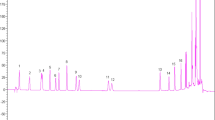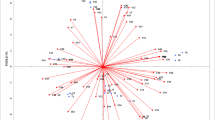Abstract
The effect of processing aids (2.5 % of talc, NaCl or KCl) on oil extractability and the profile of phenolic and volatile compounds of Istarska bjelica and Leccino oils was studied. Talc significantly increased extractability in both cultivars, while salts increased extractability in Leccino cv. In the laboratory extracted oils, phenols were determined by a RP-HPLC–DAD method, whereas volatiles were determined by SPME/GC–MS. Talc addition significantly decreased hydroxytyrosol and increased ligstroside derivatives in produced oils, but did not affect the total phenol content. Among volatile compounds, only Z-2-penten-1-ol in Leccino and 1-pentene-3-one in Istarska bjelica oils significantly increased by talc addition. Salts improved transfer of most individual phenols into oil, particularly oleuropein derivatives, and increased C6 aldehydes and C5 volatiles in Leccino oils. NaCl exerted a stronger effect in increasing individual phenols and volatiles than KCl.
Similar content being viewed by others
References
Di Giovacchino L (2013) Technological aspects. In: Aparicio R, Harwood J (eds) Handbook of olive oil. Analysis and properties, 2nd edn. Springer, New York, pp 57–96
Canamasas P, Ravetti LM (2014) Evaluation of traditional and new processing aids for olive oil extraction. Acta Hortic 1057:677–684
Beltrán G, Uceda M, Jiménez A, Aguilera MP (2003) Olive oil extractability index as a parameter for olive cultivar characterization. J Sci Food Agr 83:503–506
Cruz S, Yousfi K, Pérez AG, Mariscal C, Garcia JM (2007) Salt improves physical extraction of olive oil. Eur Food Res Technol 225:359–365
European Commission (2001) Council regulation (EC) No 1513/2001 of 23 July 2001 amending Regulations 136/66/EEC and (EC) No 1638/98 as regards the extension of the period of validity of the aid scheme and the quality strategy for olive oil. Off J Eur Commun L201: 4–7
Cert A, Alba J, León-Camacho M, Moreda W, Pérez-Camino MC (1996) Effects of talc addition and operating mode on the quality and oxidative stability of virgin olive oils obtained by centrifugation. J Agr Food Chem 44:3930–3934
IOC (2011) Guide for the determination of the characteristics of oil-olives. International Olive Council COI/OH/Doc. no 1 November 2011
Ben-David E, Kerem Z, Zipori I, Weissbein S, Basheer L, Bustan A, Dag A (2010) Optimization of the Abencor system to extract olive oil from irrigated orchards. Eur J Lipid Sci Technol 112:1158–1165
Carrapiso AI, García A, Petrón MJ, Martín L (2013) Effect of talc and water addition on olive oil quality and antioxidants. Eur J Lipid Sci Technol 115:583–588
Koprivnjak O, Brkić Bubola K, Kosić U (2015) Sodium chloride compared to talc as processing aid has similar impact on volatile compounds but more favorable on ortho-diphenols in virgin olive oil. Eur J Lipid Sci Technol. doi:10.1002/ejlt.201500014
Moya M, Espínola F, Fernández DG, de Torres A, Marcos J, Vilar J, Josue J, Sánchez T, Castro E (2010) Industrial trials on coadjuvants for olive oil extraction. J Food Eng 97:57–63
Aguilera MP, Beltran G, Sanchez-Villasclaras S, Uceda M, Jimenez A (2010) Kneading olive paste from unripe ‘Picual’ fruits: I. Effect on oil process yield. J Food Eng 97:533–538
Caponio F, Monteleone JI, Martellini G, Summo C, Paradiso VM, Pasqualone A (2014) Effect of talc addition on the extraction yield and quality of extra virgin olive oils from Coratina cultivar after production and during storage. J Oleo Sci 63(11):1125–1132
Aguilera MP, Jimenez A, Sanchez-Villasclaras S, Uceda M, Beltran G (2015) Virgin olive oil bitterness and pungency from unripe ‘Picual’ fruits can be modulated by malaxation conditions. Eur J Lipid Sci Technol. doi:10.1002/ejlt.201400432
Pérez AG, Romero C, Yousfi K, García JM (2008) Modulation of olive oil quality using NaCl as extraction coadjuvant. J Am Oil Chem Soc 85:685–691
Poljuha D, Sladonja B, Brkić Bubola K, Radulović M, Brščić K, Šetić E, Krapac M, Milotić A (2008) A multidisciplinary approach to the characterisation of autochthonous Istrian olive (Olea europaea L.) varieties. Food Technol. Biotech 46(4):347–354
Koprivnjak O, Majetić V, Brkić Bubola K, Kosić U (2012) Variability of phenolic and volatile compounds in virgin olive oil from Leccino and Istarska bjelica cultivars in relation to their fruit mixtures. Food Technol Biotech 50(2):216–221
IOC (2009) Determination of biophenols in olive oils by HPLC. International Olive Council COI/T.20/Doc No 29 November 2009
Majetić Germek V, Koprivnjak O, Butinar B, Pizzale L, Bučar-Miklavčič M, Conte SL (2013) Influence of phenols mass fraction in olive (Olea europaea L.) paste on volatile compounds in Buža cultivar virgin olive oil. J Agr Food Chem 61:5921–5927
Vichi S, Castellote AI, Pizzale L, Conte LS, Buxaderas S, Lopez-Tamames E (2003) Analysis of virgin olive oil volatile compounds by headspace solid-phase microextraction coupled to gas chromatography with mass spectrometric and flame ionization detection. J Chromatogr A 983:19–33
Garcia-Esteban M, Ansorena D, Astiasarán I, Ruiz J (2004) Study of the effect of different fiber coatings and extraction conditions on dry cured ham volatile compounds extracted by solid-phase microextraction (SPME). Talanta 64:458–466
Mildner-Szkudlarz S, Jelen HH (2008) The potential of different techniques for volatile compounds analysis coupled with PCA for the detection of the adulteration of olive oil with hazelnut oil. Food Chem 110:751–761
Noubigh A, Abderrabba M, Provost E (2007) Temperature and salt addition effects on the solubility behaviour of some phenolic compounds in water. J Chem Thermodyn 39:297–303
Fernández-Hernández A, Mateos R, Garcia-Mesa JA, Beltrán G, Fernández-Escobar R (2010) Determination of mineral elements in fresh olive fruits by flame atomic spectrometry. Span J Agric Res 8:1183–1190
McClements DJ (2007) Critical review of techniques and methodologies for characterization of emulsion stability. Crit Rev Food Sci 47(7):611–649
Pérez-Juan M, Flores M, Toldrá F (2007) Effect of ionic strength of different salts on the binding of volatile compounds to porcine soluble protein extracts in model systems. Food Res Int 40:687–693
Inarejos-García AM, Fregapane G, Desamparados Salvador M (2011) Effect of crushing on olive paste and virgin olive oil minor components. Eur Food Res Technol 232:441–451
Rabe S, Krings U, Berger RG (2003) Initial dynamic flavour release from sodium chloride solutions. Eur Food Res Technol 218:32–39
Acknowledgments
This work was supported by the Ministry of Science, Education and Sports of Republic of Croatia (Project no. 062-0580696-0284) and has been supported in part by the University of Rijeka under the Project Number: 13.06.1.4.50. Ph.D. student V. Majetić Germek was partially supported by an Alpe-Adria Research Grant from the University of Udine and a Bilateral Mobility Grant from the Ministry of the Republic of Slovenia for Higher Education, Science and Technology. The authors gratefully acknowledge Vasilij Valenčič and Milena Marega for providing technical assistance and to Ervin Bellè for the olive fruit donation.
Author information
Authors and Affiliations
Corresponding author
Ethics declarations
Conflict of interest
The authors declare that they have no conflicts of interest.
About this article
Cite this article
Majetić Germek, V., Butinar, B., Pizzale, L. et al. Phenols and Volatiles of Istarska Bjelica and Leccino Virgin Olive Oils Produced with Talc, NaCl and KCl as Processing Aids. J Am Oil Chem Soc 93, 1365–1372 (2016). https://doi.org/10.1007/s11746-016-2893-7
Received:
Revised:
Accepted:
Published:
Issue Date:
DOI: https://doi.org/10.1007/s11746-016-2893-7




